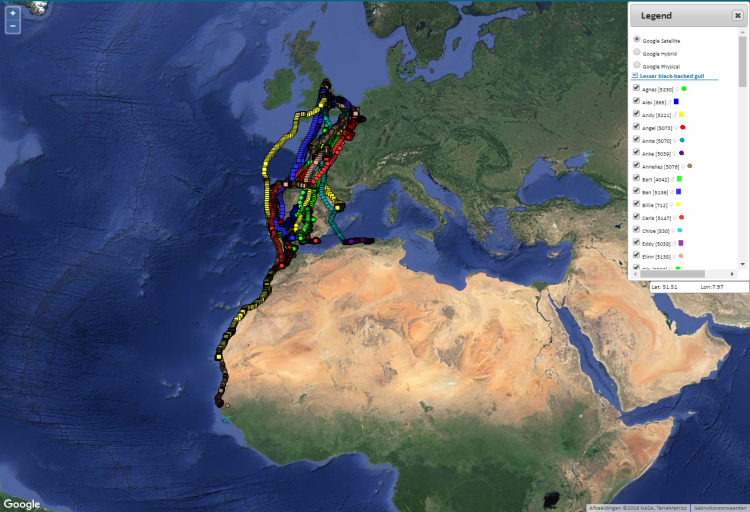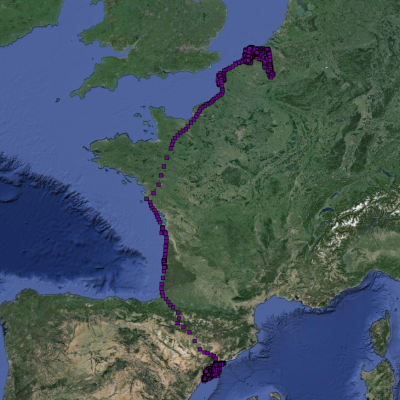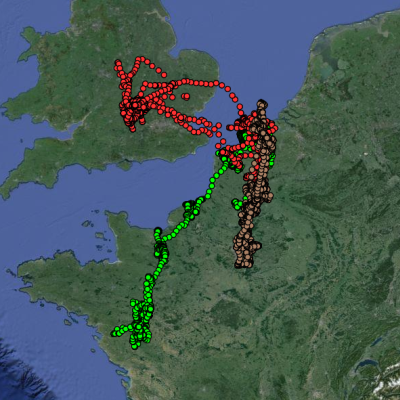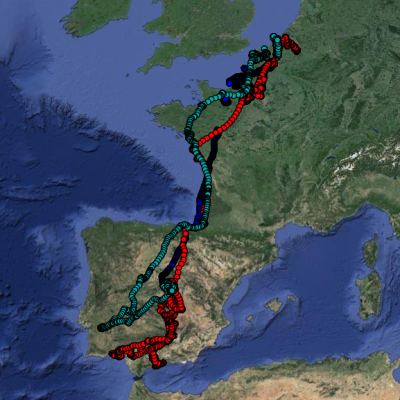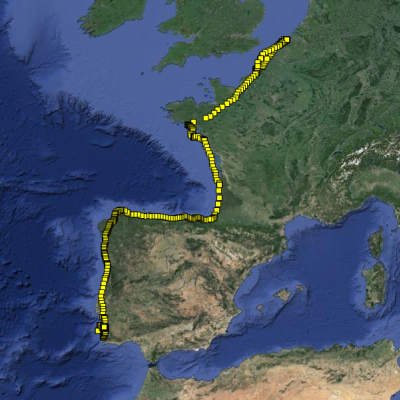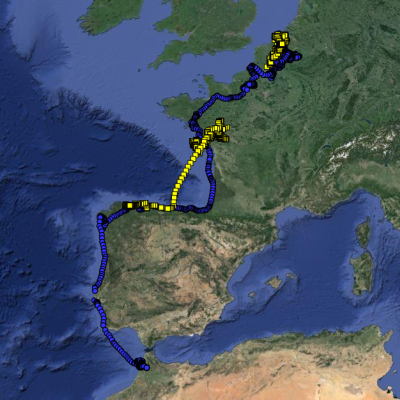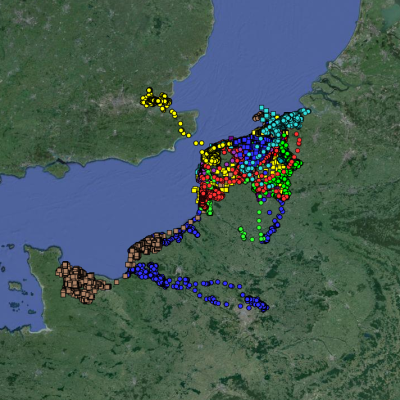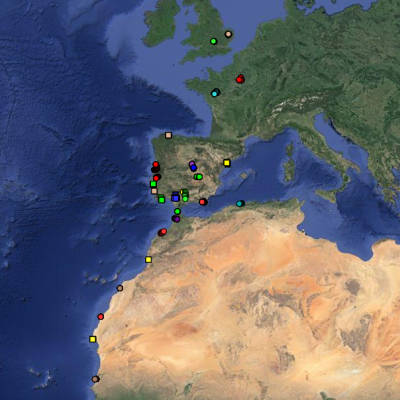You are here
Autumn migration 2015-2016
|
During August 2015, the first Lesser Black-backed Gulls started their autumn migration and exchanged their breeding grounds in Zeebrugge for their winter grounds in the South of Spain and Portugal and North Africa. Most birds however, left Flanders in the course of October-November, which is a little later than last year. By the end of November, the last tagged gulls left Flanders. Some birds traveled over land, while others seemed to prefer to follow the coastlines. A few Lesser Black-backed Gulls however decided to not migrate South this year. Unfortunately no data is available (yet) for the Western Marsh Harriers. By clicking on the map on the right, you are redirected to an interactive map displaying the autumn migration of 2015 of the Lesser Black-backed Gulls. Below you can read some peculiar travel stories. |
|
Sanne is still defeating Steven Last year, Steven (4040) (♂), was defeated by Sanne (833) (♀), in the Lesser Black-backed Gulls' race to the South. He only made it to Port-Étienne, at the border between Western Sahara and Mauritania, while Sanne flew much further South, along the Senegalese coast and even beyond Dakar. The 2015 autumn migration seemed liked a repetition of last year: both birds spent some time in the UK first, Sanne started traveling South first, Steven only left the UK by mid-October, both birds flew to the exact same spots as last year, and Sanne defeated Steven. Either Steven really enjoys the town of Port-Étienne, or he's not a very competitive bird. Maybe next year will be Steven's year? For an animated visualization of Steven's and Sanne's race, click on the image on the left. |
||
|
From the Westerschelde to the Ebro Roland-Jan (5134), a male Lesser Black-backed Gull, sure likes his river plains! Roland-Jan is a member of the Vlissingen Gang. Early August 2015, he decided it was time to leave the Westerschelde Estuary behind, and headed for his winter home. He made a short stop at the Boulonnais coast, crossed the French mainland to Nantes, followed the coast until the Spanish border, flew towards Barcelona, and reached the Ebro Delta by the Balearic Sea around mid-August. There he stayed until winter was over. For an animated visualization of Roland-Jan's river-to-river trip, click on the image on the left. |
||
|
Imme, Katrien and Yente, the lazy ones? Just like last year, it seemed Yente (5060), a female Lesser Black-backed Gull, did not travel South during the Winter season of 2015-2016, but only went as far as Paris. However, it seems some data is missing, so no way to say for certain. Also Imme (5199) (♀), seemed not to be very eager to travel all the way South. She settled for the vicinity of Nantes, instead of the warmer South of Spain. And remember Katrien (1402) (♀), who was the last gull to leave the UK party last year? Well, this year, she didn't leave the UK at all, and stayed there for the entire winter! Was the winter season of 2015-2016 warm enough to stay North, or are these just lazy birds...? For an animated visualization of Imme's, Katrien's and Yente's laziness, click on the image on the left. |
||
|
Janis (5133), Luan (5137) and Luna (5215), three female Lesser Black-backed Gulls, seemed to be big enthusiasts of the city of Madrid. During the winter season of 2015-2016, both Luan and Luna spent a lot of their time in the big city. Luan did go to Málaga and some other smaller cities for a while, but decided Madrid was more to her liking after all. Janis only arrived in Madrid mid-January, after spending some time in the North of France. In February all birds can be seen together in Madrid for a brief period of time. For an animated visualization of urban girls Janis, Luan and Luna, click on the image on the left. |
||
|
I forgot to turn of the stove! After foraging along the entire Belgian coast during the Summer of 2015, Peter (4047), a male Lesser Black-backed Gull, started his autumn migration around August 7th 2015. By the time he reached Dieppe however, he suddenly returned to Zeebrugge. Did he forget something? Perhaps to turn of the stove? After this little hiccup, he then flew from Zeebrugge to Sines, a small Portuguese coastal town, in one go. During this long trip, which only took him a couple of days, he limited the amount of stops to a bare minimum. Presumably to make up for lost time? For an animated visualization of forgetful Peter, click on the image on the left. |
||
|
Anke (5039) (♀) and Vincent (5062) (♂), two Lesser Black-backed Gulls, seemed to be very late with their autumn migration. At the end of November 2015, Anke slowly made her way to somewhere North of Paris, where she stayed for about 1 month. Early January she then finally set course for North Morocco, somewhere between Tanger and Rabat. Vincent left Flanders even later, presumably mid-January (cannot be said with certainty, since some data is missing). Late January-Early February he spent some time around Nantes. Mid-February he then finally reached his final destination, North Spain. For an animated visualization of late birds Anke and Vincent, click on the image on the left. |
||
|
Most Herring Gulls, not being migratory birds, stayed in Flanders during the winter of 2015-2016. Several birds however, visited Northern France on a regular basis, e.g. Leslie (6013) (♀), Stephanie (6036) (♀) and Wendy (6037) (♀) resided at the Boulonnais coast, and Roeland (6002) (♂) even traveled as far as Normandy. Several other Herring Gulls [Jan (6001) (♂), Karen (6003) (♀), Klaas (6070) (♂), Luc (799) (♂), and Wilma (783) (♀)], regularly visited the site of a waste treatment facility (Baudelet Environnement) in Blaringhem. The bravest Herring Gull of the bunch however must be Magda (6043) (♀), who crossed the pond and even traveled to the UK! For an animated visualization of the wintering Herring Gulls, click on the image on the left. |
||
|
During the winter season of 2015-2016 (December to February), the three bird species had different winter locations. The Lesser Black-backed Gulls left cold Flanders for warmer places and could be found in the vicinity of Coimbra, Lisbon, Sevílla, Tanger, Casablanca, and along the coasts of Algeria, Western Sahara, Mauritania, and even Senegal!. The European Herring Gulls, not being migratory birds, didn't leave their breeding grounds and remained in Ostend, although some of them could be found in the UK, along the Boulonnais coast and in Normandy. Unfortunately, no data is available (yet) for the Western Marsh Harriers. To see where the birds spent their winter, click on the image on the left. |

